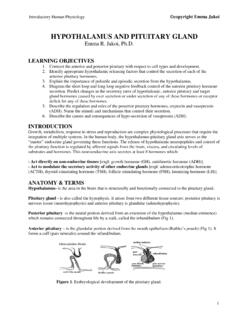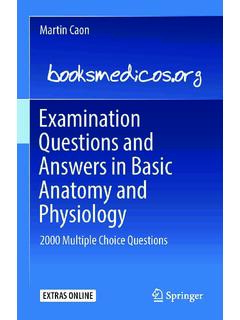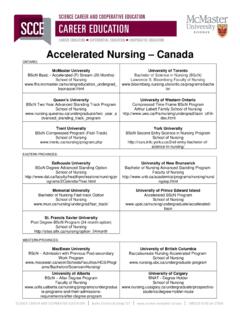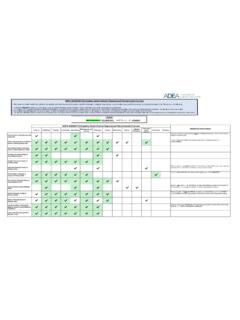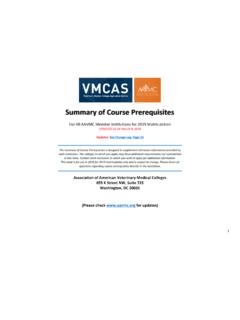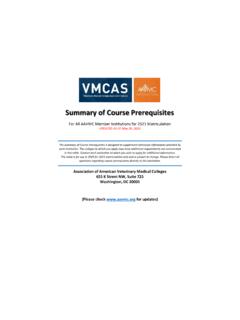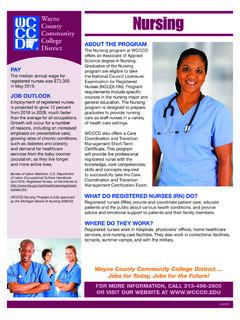Transcription of Respiratory System Physiology - Duke University
1 introductory Human Physiology copyright Jennifer Carbrey & Emma Jakoi 1 Respiratory System Physiology Mimi Jakoi, PhD Jennifer Carbrey, PhD The underlined headings correspond to the eight Respiratory System videos. 1. Anatomy and Mechanics Introduction The Respiratory System carries out several homeostatic functions, including: 1. gas exchange between the atmosphere and the blood to provide an adequate supply of oxygen to tissues and to remove carbon dioxide (CO2) generated in oxidative metabolism. O2 + Food = CO2 + H2O + ATP 2. regulation of body pH by either retaining or eliminating CO2 3. conversion of angiotensin I to angiotensin II which acts to control blood pressure 4. protection from inhaled particles. In the Respiratory System , air flow occurs by bulk flow from regions of high pressure to lower pressure with the pressure differences generated by a muscular pump.
2 Resistance to air flow is influenced primarily by the radius of the tube (1/r4) through which air is flowing. F = (P1 P2)/R The movement of fresh air into the lung (inspired) or out of the lung (exhaled) is called ventilation. Both the rate and size of the breath (tidal volume) can change in response to needs of the body. Anatomy The Respiratory System consists of structures involved in moving air into and out of the lungs (bulk flow) and in gas exchange (diffusion). LUNGS AND CHEST WALL act as a unit. Each lung is surrounded by a membranous sac (pleura) filled with a thin film of fluid (Fig. 1). This intrapleural fluid serves as a lubricant so the lungs can move freely within the chest wall and functionally connects the lungs to the chest wall such that expansion of the chest expands the lungs. CONDUCTING ZONE leads from the external environment to the gas exchange surfaces of the lungs (Fig.)
3 1). This zone includes a series of tubes (nasal cavity, pharynx, trachea, bronchus, and bronchioles) with small radii and small surface areas. Their total volume is about 150 ml. Since no gas exchange occurs in the conducting zone, it is often called the anatomical dead space. Figure 1 Anatomy of the Respiratory System . Image by OCAL, , public domain introductory Human Physiology copyright Jennifer Carbrey & Emma Jakoi 2 Respiratory ZONE is the region of the lung where gas exchange occurs (Fig. 2). The Respiratory zone is much larger than the conducting zone and has a volume of about 3 L. It consists of Respiratory bronchioles, alveolar ducts and alveoli. The alveoli are small sac-like structures with very thin walls wrapped by capillaries (Fig. 2). The 300 million alveoli provide a surface area of about 70 m2. Here oxygen (O2) diffuses from the air space to the blood and carbon dioxide (CO2) diffuses from the blood to the air space.
4 The distance that gas has to diffuse is very short, about microns, making the alveolus-capillary unit ideally suited for gas exchange. TYPE I CELLS are thin epithelial cells that line about 90% of the surface area of the alveoli. Gases diffuse across the type I cells to and from the blood (Fig. 2). TYPE II CELLS are interspersed among the type I cells. Type II cells synthesize, secrete, and metabolize alveolar surfactant. Surfactant is a lipid-rich substance that lines the alveoli and helps keep lungs from collapsing. ALVEOLAR MACROPHAGES are the third type of cell found in alveoli. Macrophages engulf inspired particles such as bacteria. These cells are mobile and are attracted to areas of either infection or trauma. Pulmonary Function BREATHING is the process of inspiration (air flows into the lung) and exhalation (air flows out of the lung).
5 Inspiration begins when the diaphragm and the intercostal muscles of the chest wall contract in response to neural impulses from the brain stem (Fig. 3). Contraction of the diaphragm causes it to descend and contraction of the intercostal muscles raises the ribs; the chest cavity expands. Because the lungs are functionally connected to the chest wall by the pleural sac, the lungs also expand (Fig. 3). This increase in lung volume reduces the air pressure in the alveolar ducts and alveoli. When the pressure in the alveoli (PA) becomes less than the pressure at the mouth, which is ordinarily atmospheric pressure (Patm), air flows in until PA = Patm (Fig. 3). Exhalation occurs when the muscles of inspiration relax. The lung returns passively to its pre-inspiratory volume due to its elastic properties. This reduction in volume raises the pressure in the lung causing air to flow out.
6 Figure 3. Expansion and contraction of the alveolar space alters the pressure of air within. Image by Mohamed Ibrahim, , public domain Figure 2. Respiratory zone of the lung. Image by Mohamed Ibrahim , , public domain introductory Human Physiology copyright Jennifer Carbrey & Emma Jakoi 3 VENTILATION CYCLE is one inspiration and exhalation. Ventilation rate (f) is in the range of 10-18 breaths per min. Both the rate and depth can be changed by output from the Respiratory centers in the brain stem (medulla oblongata). During heavy exercise air flow can increase 20-fold and blood flow 3-fold. To expel such increased volumes, active exhalation is required in which abdominal muscles and internal intercostals muscles contract. These actions actively decrease the size of the thorax (chest cavity). 2. Lung volumes and compliance LUNG VOLUMES are determined by the interaction of the lung and chest wall.
7 The lungs are elastic like a rubber band. They expand during inspiration and recoil passively during exhalation. Functional residual capacity (FRC) is the resting volume of the lung and chest wall. It occurs when the elastic recoil of the lung (pulling inward) balances the pressure of the chest wall to expand (pulling outward). When chest wall muscles are weak, FRC decreases. Lung volumes play a major role in gas exchange and in the work of breathing. They are measured under dynamic and static conditions. Dynamic volumes refer to measurements made when volumes are changing, , during gas flow. Static volumes can be measured between two points where there is no flow, for example before and after inspiration. There are four standard lung volumes (Fig. 4). There are also four standard lung capacities, which consist of a combination of two or more volumes.
8 A spirometer is used to measure lung volumes directly. All volumes except the residual volume (amount of air remaining in the lung at all times) can be measured with a spirometer. Figure 4. Lung volumes and capacities. image by Vihsadas (modified), , public domain Residual volume (RV): Amount of air in the lungs at the end of maximal exhalation (~ L young men). Tidal volume (TV): Volume of air inhaled or exhaled with each breath (in adult males ~ ; in females usually about 20- 25% less). introductory Human Physiology copyright Jennifer Carbrey & Emma Jakoi 4 Inspiratory reserve volume (IRV): Volume of air that can be inspired after a normal inspiration (~ L in males). Expiratory reserve volume (ERV): Maximal volume of air that can be expired (exhaled) from resting expiratory level (~ L in males). Inspiratory capacity (IC=TV+IRV): Maximal volume of air that can be inspired from resting expiratory level (~ L in males).
9 Functional residual capacity: (FRC=RV+ERV): Volume of air in lungs at end of a normal exhalation. (~ L in males) (see Fig. 4). Vital capacity (VC=ERV+TV+IRV): Volume of air that can be exhaled after maximal inspiration (~ L) Total lung capacity (TLC=RV+ERV+TV+IRV): Volume in lungs at end of maximal inspiration (~6 L). Changes in lung volumes are some of the earliest indicators of lung disease. One of the most informative is the ratio of RV and TLC. Normally RV/TLC ratio is less than , that is the air trapped in the lung is ~25% of the total lung volume. In obstructive lung diseases the amount of trapped air (RV) increases, hence RV/TLC increases. In restrictive lung disease in which the lung can not fill normally, RV/TLC also increases but in this case, total lung volume (TLC) is reduced disproportionate to residual volume. Elastic Recoil and Compliance LUNG COMPLIANCE is defined as the stretchability of the lung for any 1-cm change in pressure across the lung.
10 CL = VL/ (PA Pip) The greater the compliance, the easier it is to expand the lungs at any given change in trans-pulmonary pressure. Compliance is the inverse of elastic recoil or stiffness. The most common way to obtain a compliance curve is to have an individual inspire to total lung capacity and then exhale slowly in small increments. When airflow is temporarily stopped, volume and transpulmonary pressure are recorded. A pressure-volume curve is constructed (Fig. 5). The slope of the pressure - volume curve at any given point is lung compliance at that point. Note that the pressure-volume curve is not linear (Fig. 5). At high lung volumes, the lungs are almost maximally stretched and a large change in pressure produces only a small change in Figure 5. Pressure-volume relationship during inflation of isolated lungs. In the restrictive lung disease, fibrosis, the lung shows decreased compliance and reduced volume (vital capacity).
